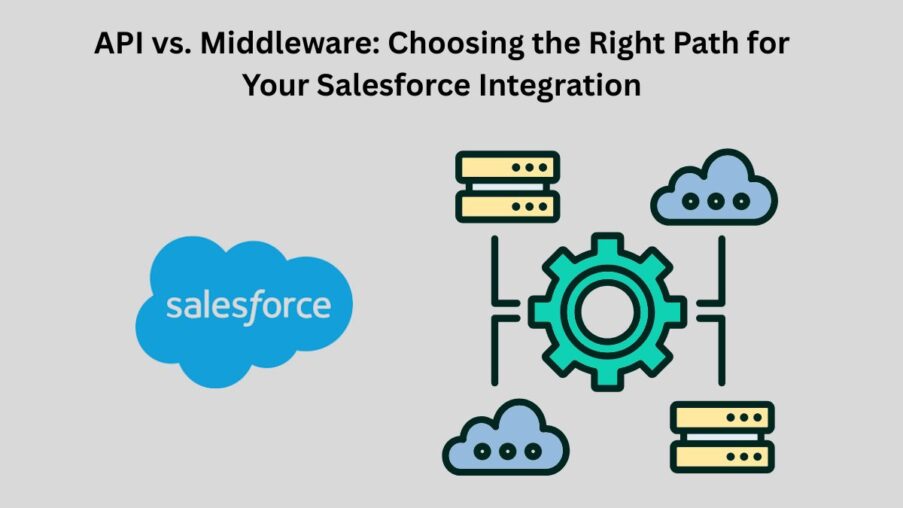In today’s hyper-connected business environment, seamless data flow across systems is no longer a luxury—it’s a necessity. As organizations increasingly rely on Salesforce as the central hub for customer engagement, integrating it effectively with other platforms—whether it be ERPs, marketing automation tools, financial systems, or custom applications—is critical to unlocking its full potential.
When planning a Salesforce integration, one of the biggest architectural decisions is choosing between APIs and middleware. Both approaches have distinct advantages, challenges, and use cases. Understanding these differences is vital for selecting the right path tailored to your business’s complexity, budget, and scalability needs.
Understanding Salesforce Integration Needs
Before diving into the technical comparison, it’s important to ask a foundational question: What do you need your integration to achieve?
Some of the common goals include:
- Real-time data sync across systems (e.g., order updates from an eCommerce site to Salesforce)
- Batch processing of data (e.g., nightly sync of financial data)
- Streamlined workflows for marketing, sales, and customer support
- Data centralization for analytics and reporting
- Automation of manual processes
The choice between API-based or middleware-based integration hinges on how complex these needs are and how rapidly they are expected to evolve.
What is API-Based Integration?
APIs (Application Programming Interfaces) allow two systems to communicate directly by exposing endpoints for data access and operations. Salesforce offers a robust suite of APIs, including:
- REST API: Lightweight and ideal for mobile or web applications
- SOAP API: Suitable for complex enterprise systems requiring strict standards
- Bulk API: For handling large data volumes efficiently
- Streaming API: Enables push-style data updates in real time
With API-based integration, developers write custom code to directly call these Salesforce APIs from external systems (or vice versa).
Pros of API-Based Integration
- Real-Time Data Access: APIs provide instantaneous access and updates, ideal for scenarios where timely information is critical (e.g., sales rep needing real-time inventory).
- Highly Customizable: Developers have full control over which fields to sync, how data is formatted, and when calls are made.
- Fewer Dependencies: No third-party systems to manage, reducing external dependencies and licensing costs.
- Lower Initial Cost: For simple, point-to-point integrations, APIs are cost-effective and quick to implement.
Cons of API-Based Integration
- Maintenance Overhead: With every system change, your custom code may need updates. This can create long-term technical debt.
- Limited Scalability: As you add more systems and processes, point-to-point APIs can become tangled and difficult to manage.
- Error Handling Complexity: You’re responsible for retry logic, exception handling, and data conflict resolution.
- Resource Intensive: Requires strong development expertise in both Salesforce APIs and the target system.
What is Middleware-Based Integration?
Middleware refers to third-party integration platforms that act as intermediaries between systems. Examples include MuleSoft (owned by Salesforce), Dell Boomi, Jitterbit, Informatica, and Zapier.
These platforms offer pre-built connectors, visual flow designers, and orchestration tools that simplify the process of connecting Salesforce to a wide array of applications.
Pros of Middleware Integration
- Scalability & Flexibility: Middleware supports complex integration patterns—multi-step workflows, conditional logic, and multiple system touchpoints—without adding excessive code.
- Faster Deployment: With drag-and-drop interfaces and pre-built templates, integration time is reduced significantly.
- Robust Error Management: Middleware platforms offer built-in logging, retry mechanisms, and monitoring dashboards.
- Standardized Architecture: Encourages a hub-and-spoke model that simplifies long-term system architecture.
- Enterprise-Grade Security & Compliance: Most middleware tools offer encryption, role-based access, and support for GDPR, HIPAA, etc.
Cons of Middleware Integration
- Higher Cost: Subscription fees, connector usage charges, and possible onboarding costs can be a barrier for small to mid-sized businesses.
- Learning Curve: While coding is reduced, teams still need to understand middleware tools and invest in training or hiring.
- Platform Lock-in: Some tools may make it difficult to migrate integrations if you later switch platforms.
When to Choose API-Based Integration
- You have simple, point-to-point integration needs
- Your internal team has strong Salesforce development expertise
- You’re working with limited budget and can handle future maintenance
- Real-time data sync is crucial for a few specific systems
When to Choose Middleware Integration
- You need to integrate multiple systems (ERP, HRM, eCommerce, etc.)
- Your workflows are complex and require conditional logic or orchestration
- You want a centralized, maintainable, and scalable architecture
- Your business operates in a regulated industry that requires detailed logs and audit trails
Hybrid Approach: The Best of Both Worlds
In many enterprises, a hybrid approach works best. For example, you might use:
- API integration for real-time updates between Salesforce and a website
- Middleware for batch updates, data transformations, and orchestrating cross-functional workflows
This strategy allows for agility while maintaining structured control over broader processes.
Conclusion
Choosing between API and middleware for your Salesforce integration isn’t a one-size-fits-all decision—it depends on your current infrastructure, future roadmap, resource availability, and business goals.
APIs provide speed and control for straightforward use cases, while middleware offers a powerful, scalable solution for enterprise-grade integrations. Evaluating these options with the help of experienced Salesforce consulting services can ensure that your integration strategy not only meets today’s needs but is also future-ready.
No matter which path you choose, the end goal remains the same: enabling seamless, intelligent, and efficient workflows that drive business growth.





